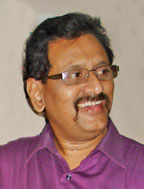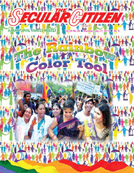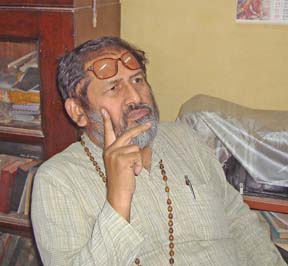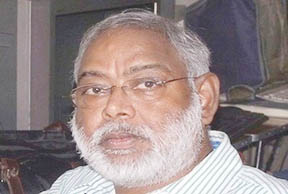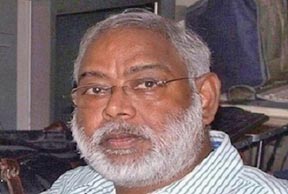
By John Dayal
The Church in India – Catholic, Protestant, Evangelical and Pentecostal – may in future confine itself to just worship and running Colleges, schools, hospitals and some charity activities, if current political trends play out their expected course. The church’s ‘preferential action for the poor,’ its track record in giving a voice to the voiceless and activities in the training and empowerment of Tribals, the Dalits and other marginalised groups, would invite close government scrutiny in the future. And in a worst case scenario, its resources could be cut off and its personnel find their activities restrained under the twin onslaught of a major move to take the infamous Foreign Contributions Regulation Act to new levels of strictness and harshness, and a fresh bout of police and political action – including by self styled ‘social-cultural’ groups such as the right wing Rashtriya Swayamsewak Sangh and its branches such as Vanvasi Kalyan Ashram which works in central India’s vast Chhotanagpur Tribal belt.
The Church will not be alone in being impacted in this doomsday scenario of something horribly gone wrong in India’s political discourse and its development landscape. Keeping it company will be major Non Governmental Organisations, NGOs, funded by international organisations involved in rights-based campaigns against the denudation of forests and ravaging of rivers, and supporting people’s protests and movements against genetically modified crops such as cotton and brinjal, the dangers of suspect nuclear power plans in the post Fukushima Daiichi nuclear disaster in Japan on 11 March 2011, or the resistance of Orissa Tribals to the attempts of Korean giant Posco to mine their sacred hills and forests.
This seemingly alarmist projection is born of the enthusiastic support of the new government in New Delhi led by Prime Minister Mr. Narendra Modi and his Bharatiya Janata Party to a report by the Intelligence Bureau [IB], leaked to select media, on what it says is the loss to the national exchequer, and to the country’s development, by the work of organisations receiving foreign funding through the FCRA. The report, which hogged Television News headlines for days, specifically focused on a short list of NGOs and some of the country’s most well known rights activists. Highlighted were the activities of such organisations as Greenpeace, and such people as the late Fr Tom Kotcherry of the Fisherman’s movement, Vandana Shiva working on food and crop issues and S P Udaykumar of Tamil Nadu who was involved in the struggle of sea coast dwellers who were afraid the nuclear power plant being built by Russian assistance in Koodmakulam in Trinalvelli district of Tamil Nadu was not safe and would poison the coastal waters. The government had already blacklisted the European finding agency Cordaid. It went on to now put severe restrictions on the FCRA licence of Greenpeace, saying it would have to take prior permission before it could receive funding in future for its projects.
The Church of the region was in the past dragged into the controversy, and the FCRA of a Catholic diocese was impacted. Some of its clergy and religious were also subjected to police scrutiny, and action.
This reporter has an e-copy of the photocopy of the IB report, which was leaked on TV and is now going viral on the Internet. The document says the NGOs’ activities are “contributing to the negative impact on India’s GDP growth assessed to be 2 – 3 % p.a. The IB did not indicate how it reached this conclusion or the data on which it was based. Circumstantial evidence suggests that this targetting of NGOs would benefit international companies such as Vedanta and Posco, and some of the Indian corporate giants whose projects have faced popular protest.
It is important to quote the TimesNow reportage on the IB report as it was the first news channel to which the intelligence agency gave its secret document.
On 12th June 2014, its prime time report said:
“NGOs use funds for fuelling protests: IB report to PMO — An Intelligence Bureau report to the Prime Minister’s Office and other departments has noted that funding of several Non-Governmental Organisations (NGOs) is “cleverly disguised” as donations for issues like human rights and instead used for funding protests to stall developmental projects. These funds were mostly used to fuel protests against developmental projects relating to coal, bauxite mining, oil exploration, nuclear plants and linking of rivers, resulting in stalling or slowing down of these projects, the report said. The report submitted to the PMO and other important ministries like Finance and Home also claims that laptop of one of the foreign activists of an NGO contained scanned map of India with 16 nuclear plants (existing and proposed) and five Uranium mine locations marked prominently.
“It [the IB report] said that some organisations in Western countries have also developed “deniability” by pursuing “transit-funding models” where by European donors and also governments are asked to fund some NGOs in India. ”These include the Netherlands and Danish governments and multiple state funded donors based in these countries, apart from some Scandinavian NGOs, which normally focus on the environmental impact of development,” the report, submitted also to National Security Adviser and Cabinet Secretariat, alleged. It said that in the last few years, the country has been facing problems from these organisations which have stepped up efforts to encourage growth retarding campaigns in India, focused on extractive industries including anti-coal, anti-uranium and anti-bauxite mining, oil exploration, Genetically modified organisms and foods, climate change and anti-nuclear issues.
“The report named two anti-nuclear organisations National Alliance of Anti Nuclear Movements (NAAM) and People’s Movement Against Nuclear Energy (PMANE)– spearheaded by US-educated S P Udayakumar who allegedly received “unsolicited contract” from a US university. During effective monitoring, “Udaykumar’s contact in Germany—Sonntag Rainer Hermann—was deported from Chennai on 2012 and his laptop contained scanned map of India with 16 nuclear plants (existing and proposed) and five Uranium mine locations marked prominently,” the report said. The map also included contact details of “50 anti-nuclear activists hand written on small slips of paper along with Blackberry PIN graph and was sent through email to five prominent anti-nuclear activists including Udayakumar.” ”Sustained analysis revealed that the name slips on the map were hand-written in order to avoid possible detection by text search algorithms installed e-gateways,” it said.”
Udaykumar, and everyone else mentioned in the IB report denied every single charge, stressing the legitimacy of their work, and the transparency of their funding. Udaykumar specially maintained he was being framed and his remunerations as a researcher and writer published by respected international journals were being called clandestine funding.
Church organisations have not commented on the report. This silence has been noticed. Civil society has been vocal, even though activists have also noted the silence of several prominent voices that are perhaps afraid of the system, or anticipate action against them if they side with the protests.
Researcher and writer Pushpa Sundar who has written a book on the subject of NGOs and development, says; “What is disturbing about the report is that the room for legitimate dissent by civil society seems to be shrinking. It is only when governments refuse to listen to grievances that peaceful protests turn ugly and civil society organisations resort to action to hold up projects. The action initiated by NGOs is on behalf of the sections of society that have no voice in corridors of power. If the political representatives play their role well then civil society would not need to resort to agitation. Besides, it is not necessarily foreign money, which is used for agitations. The anti-corruption movement was genuinely a people’s movement, funded by small donations, and even those donations that were received were from Indians settled abroad. Even here foreign funding was used to discredit the movement.”
The FCRA and NGO data has been on the Internet ever since the coming into effect of the Right to Information Act – itself the successful product of a prolonged NGO movement which first began in Rajasthan.
• 22,702 of the estimated 20 lakh NGOs filed returns on funding in 2011-12
• 13,291 NGOs received foreign funds; 9,509 reported receiving no foreign contribution
• Rs 11,546.29 crore is the quantum of foreign funds received by NGOs in India
• Rs 7,000 crore received by NGOs in five states: Delhi, Tamil Nadu, Andhra Pradesh, Maharashtra, Karnataka
• Rs 233.38 crore, the highest amount received, by World Vision of India, Chennai
• Rs 99.20 crore was the highest donation, from Compassion International, USA
• Rs 418.37 crore was the donation from the Netherlands
• 148 NGOs received foreign funds in excess of Rs 10 crore
• 178 NGOs received funds between Rs 5-10 crore; 1,702 between Rs 1-5 crore
• 39.73% was the highest year-on-year jump in foreign contribution to NGOs, in 2006-07
• Rs 2,253 crore of foreign contributions to NGOs goes towards ‘non-core’ activities
[Data from the Union Ministry of Home Affairs 2011-2012]
Among the definite purposes for which foreign contribution was received and utilized, the highest amount of foreign contribution was utilised for Establishment Expense, followed by Rural Development , Relief/Rehabilitation of victims of natural calamities, Welfare of Children and Construction and maintenance of schools/colleges.
Among the recipients have also been religious organisations, including some very prominent Hindu god-men and god-women.
The government does not release data on how much does the Indian corporate and business sector, the only other non-governmental group that can finance the NGOs, actually spends that money on social outreach. Most critics have slammed this sector’s much flaunted Corporate Social Responsibility as a sham, and an excuse to contribute to society just a minor percentage of the profits it makes from the people and by exploiting the country’s natural resources.
But neither the media nor the government want to highlight another major recipient of foreign money, the Sangh Parivar, and much of it is not even through the FCRA bank channels. Writers Pragya Singh and Abhijit Mazumdar in a recent article in Outlook magazine pointed out “The RSS itself is an unregistered body and submits neither income tax returns nor does it have a licence to receive money from abroad. But many of the NGOs affiliated to it are among the NGOs in India that received foreign money.
“The growth of the RSS provoked a group of US intellectuals in 2002 to ask around about its funding. They published a detailed account of how the American charity, India Development and Relief Fund (IDRF), donated much of its basket to the RSS, VHP and other Sangh-affiliated NGOs in India. Information in the public domain shows that between 1994 and 2000, most of IDRF’s $5 million fund poured into Sangh-affiliated NGOs. In those years, when a donor asked IDRF to pick an NGO on their behalf, 83 per cent of the donation wound up in a “Sangh-affiliated” one, the study discovered.. The campaign had explored the IDRF’s role in funding the ‘Vanvasi Kalyan Kendra’ which promotes “ghar wapasi” (conversion of Christian tribals to Hinduism) of tribals even at the cost of escalating violence and tensions. The IDRF annual report for 2012 shows that over $1.2 million (Rs 7.2 crore) was sent to India during the year. The following year, another million dollars (Rs 6 crore) found its way to NGOs, including Vanvasi Kalyan centres across India, especially in tribal regions like Jharkhand and Chhattisgarh.”
Needless to say, RSS-affiliated NGOs receive large sums also from governments of states ruled by the Bharatiya Janata Party and its allies. No data, however, is officially available.
The rule of thumb seems to be that organisations and NGOs that have political patronage or deemed to be nationalistic and benign, where as those that work with the people in the areas that government and others do not want to enter.
But it must be said that the Prime Minister, Mr. Narendra Modi, is following in the footsteps of his predecessors Mrs. Indira Gandhi, Mr. Atal Behari Vajpayee and Dr. Manmohan Singh, is trying to stifle dissent by starving NGOs of foreign donations.
As I have pointed out in my writings in the past, the FCRA has an evil history – it was conceived in sin, so to speak, and nurtured in suspicion and hate. It was an illegitimate child of the State of Emergency” that was imposed by the then Prime Minister Indira Gandhi in 1975. The law was brought about to curb foreign money coming to certain institutions associated, ironically with Jay Prakash Narain and some Gandhians, who, she feared, were hell bent on fomenting a coup against her.
Successive governments chose not to repeal the FCRA though they demolished several other measures she had installed during the Emergency. The 1977 elections that threw her out and brought the first Janata party into power, with Morarjee Desai as Prime minister, Atal Behari Vajpayee as foreign minister, George Fernandes as Industry minister and Lal Krishna Advani as Information and Broadcasting minister, retained it. Charan Singh and Rajiv Gandhi, in their premierships, also retained the law, as did Rajiv’s cabinet colleague turned foe, Vishwanath Pratap Singh, socialist “Young Turk” Chandrashekhar, “poor farmer” Deve Gowda mild mannered “punjabiyat” ambassador Inder Kumar Gujral when it came their turn to rule. Each found some reason to stick with the FCRA despite a sustained outcry by civil society and developmental NGOs who saw in it nothing but memories of a tyrannical and dictatorial period in India’s history.
The Bharatiya Janata Party-led National Democratic Alliance government of Prime Minister Atal Behari Vajpayee was arguably the worst ever in its record of misusing the FCRA provisions to curb dissent and throttle the voices of civil society. Their home minister, “Iron man” Lal Krishna Advani added innuendo to the normal rhetoric, repeatedly insinuating that Christian organisations were receiving massive funds for conversions, and Muslims were getting money for setting up madrasas to teach terrorism. Ministers from Mr. Advani downwards hinted they had direct evidence of all this, but each one of the worthies has shied away from the open demand by human rights groups and Christian organisations that the government come up with the proof. Dr. Manmohan Singh in his time made the FCRA provisions even harsher.
If honest investigations were to be done, many things would be clear. Terrorists, Muslims, Sikhs, Maoists or Hindus, or other insurrectionist groups, do not get their money from banking channels that the FCRA imposes. They get their money through Hawala or the underground drug, gun-running and the human trafficking rackets use.
In fact, FCRA has hurt innocent NGOs and well-meaning social workers. It has led to the fattening of crooked chartered accountants and consultants who specialize in expediting FCRA clearances, obviously in league with corrupt officials and politicians. It has also led to corruption among some sectors of civil society.
Experts have pointed out that if government has any concerns that the there is inadequate compliance with reporting the cure lies in strengthening overseeing bodies like the charities commissioner and the registrars of societies rather than penalizing a whole sector and creating ever more procedures which will only burden these bodies more.
But in real terms, there is no place for such a law in a democracy. Laws such as FEMA – the Foreign Exchange Management Act – for the corporate sector and other statutory provisions not only take care of all concerns but prevent the isolation and targetting of the apolitical social sector, of which the Christian church is such an important part. FCRA will always mean a knuckle-duster, if not a bludgeon, in the hands of a hostile and coercive regime, or a crooked official.
